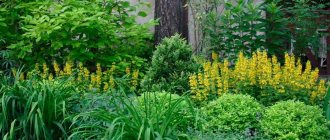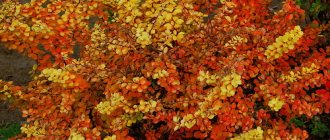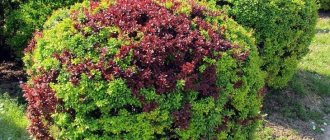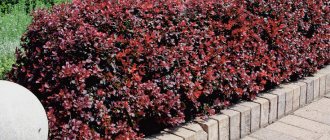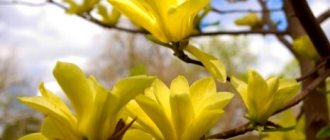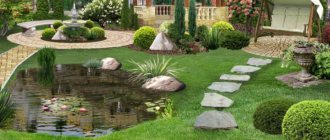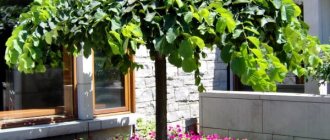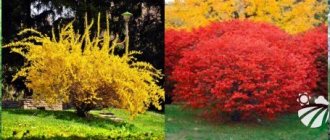Despite the fact that in the summer the garden delights with a riot of colors, many owners want to add some more bright and original touches to the landscape. Ornamental shrubs for the garden with red leaves successfully cope with this task.
These plants can transform your summer cottage beyond recognition. Such shrubs set the right accents, allowing the garden to look bright and original at any time of the year. Today we will introduce you to some of them.
Barberries with purple foliage
It is not for nothing that we begin our review with these shrubs with red leaves. Landscape designers love to use them, and gardeners also appreciate the beauty of these plants. Red-leaved barberry attracts attention with its purple foliage from early spring. It continues to delight with its decorativeness until the onset of the first frost.
These unpretentious shrubs, which harmoniously fit into any landscape, have long become welcome guests in many garden plots in the middle zone. Thanks to its unsurpassed decorative characteristics, barberry can be used everywhere - in combination with conifers, as a hedge, in single plantings. Below we will present you the most popular varieties.
Contender #5 – red-leaved plum (cherry plum)
Red-leaved plum is another unpretentious tree that can be successfully used in garden landscape design. It has dark burgundy leaves and fruits of the same color. The tree also bears fruit well. The red-leaved plum lends itself well to shaping - you can form a spherical crown, it is good both as a free-growing tree and as a hedge. The height of the hedge can be any - from quite high (2 m and above) to 60-70 centimeters. Such a hedge can be an excellent decoration and hide your area from prying eyes. Like the ornamental apple tree, the plum tree is resistant to diseases and pests.
If you want to create a truly original garden on your property and are fond of ornamental plants, be sure to pay attention to red-leaved trees and shrubs. Both in summer and autumn they will help you place the right accents in the garden and create wonderful compositions. The area will look brighter and more elegant at any time of the year, with the exception of winter cold. And fruit plants with decorative foliage - plum, apple tree, barberry - will also delight you with delicious fruits by autumn.
Source
Barberry Ottawa Superba
The shrub, whose height is about three meters, is incredibly beautiful. It is distinguished by its exquisite flowering and is a worthy decoration of any summer cottage. The barberry bush of this variety has a rather large, spreading crown with long annual growths. Numerous shoots are armed with large thorns.
The burgundy leaves have a faint metallic tint in the summer. In autumn the leaves turn bright red. Flowering begins in May. The shrubs are covered with yellow flowers with a red border, which are collected in racemose inflorescences. They have a strong and very pleasant smell.
The fruits hang spectacularly on curved branches, are somewhat elongated, edible, and have a characteristic sour taste. They are also painted bright red. The plant is light-loving, but also tolerates partial shade. In sunny areas, the color of the leaves is more saturated.
The bush tolerates extreme heat and drought well, is undemanding to soil composition, but develops better on alkaline soils. Does not tolerate stagnant moisture. It is used as a tapeworm on the lawn, to create arrays, in row plantings, in borders, and growing hedges.
Growing conditions
Many of our gardeners and landscape specialists already know about the unpretentiousness of the bladderwort. Benefits of this plant:
- drought and frost resistance
- undemanding to soil composition
- unpretentiousness in
- high degree of decorativeness
- possibility of reproduction in different ways
- the ability to create garden shapes using haircuts
- resistance to diseases and pest attacks
Despite all the advantages of bladderwort, it should be remembered that red-leaved varieties are less resistant to severe frosts, unlike the main plants. Therefore, young seedlings in the first year after planting should be covered during the winter cold. In the spring, sanitary pruning will definitely be required, during which you need to remove all frozen, dry and damaged branches. Shaping haircuts are done as needed.
Unlike the main plants, red-leaved varieties of bladderwort will grow and develop better in fertile soils. You should refrain from planting bushes with red leaves on loam, where there is a danger of moisture stagnation. Overwatering can cause plants to be damaged by powdery mildew.
In the spring, seedlings can be fed with nitrogen fertilizers, and in the fall - with potassium-phosphate fertilizers. The bladderwort does not need frequent watering.
Barberry Thunberg
A bright representative of a large family. Such barberry bushes are beautiful in winter - against the background of snow, its reddish stems, covered with small thorns, look very impressive. In the spring, when the plant awakens, its leaves are painted in an unusually beautiful copper-red color and, in contrast with them, tassels of yellow flowers bloom. In summer, the leaves of Thunberg barberry are painted in rich purple shades, and in autumn the bushes simply fascinate with their beauty. The bright colors of the flame cover the entire bush from below to the tips of the graceful and elongated branches.
Barberry Thunberg has many varieties. We will tell you about the most common red ornamental shrubs.
Atropurpurea Nana
This is perhaps Thunberg's most popular barberry. A miniature shrub with red leaves, the height of which does not exceed sixty centimeters. Its crown is compact, flat-round. Differs in rather slow growth. It blooms with beautiful flowers: they are yellow inside and bright red outside, forming racemose inflorescences. Bright red fruits remain on the branches throughout the winter.
The leaves are small, at first they are dark red (almost black) in color, then become rich red. In autumn they turn bright red. The plant is undemanding to soil and has proven itself well in urban environments.
Admiration
A miniature shrub with red leaves of extraordinary beauty. An adult plant does not exceed 50 cm in height, and this is with the same diameter of the crown, which has a round shape. It's very dense. The leaves are small red with an original thin yellow border.
The flowers are yellow, with a slight reddish tint, and can be solitary or in bunches. Flowering occurs in May. The fruits are oblong, raspberry-red, and fully ripen in October.
It is undemanding to soils and grows well in urban environments. Grows best in well-lit areas. Used to create low borders, in rocky hills, in compositions, for single and group planting.
Bagatelle
Dwarf shrubs with red leaves are unusually good. An example of this is Bagatelle. Its height is about forty centimeters, while the diameter of the crown can reach a meter. The annual increase in width and height is about three centimeters.
These unpretentious shrubs have a fairly dense crown. The leaves are ovoid, no more than one and a half centimeters long, dark red. In autumn they turn carmine red.
It blooms in May with yellow-red small flowers collected in beautiful clusters. The fruits are bright red, shiny, up to a centimeter in size. As a rule, they ripen in early October.
It is undemanding to soil and tolerates short-term drought well. Used in rockeries, ridges, group plantings, rock gardens, borders.
Common hazel
Hazel is used not only to decorate garden plots, but also to obtain healthy nuts. This deciduous shrub can grow up to ten meters in height and has a powerful root system that grows in the upper layers of the soil. Leaves on short petioles up to 10-12 cm long and 8-12 cm wide, double-serrate with sharp ends, are green in spring and summer, and closer to autumn the color changes to red. Young branches, petioles and leaves have thick, hairy down. It blooms with small flowers of two types. Male flowers are collected in earring-shaped inflorescences, female flowers are erect or cone-shaped. In autumn, fruits are formed, with a circumference of up to 1.5 cm, which change their color during ripening from light brown to dark brown. Flowering begins in April and continues until the leaves bloom. The fruits ripen in September. Common hazel can often be found in oak coniferous or mixed forests of Europe or the Caucasus. There are many plantings in Russia and Ukraine. The life span of a tree is about 100 years. The kernels of the nuts are used in folk medicine to treat atherosclerosis and heart diseases. An infusion is made from the bark, which is used for perephlebitis and varicose veins, as well as for the treatment of skin diseases. Nut oil strengthens the stomach and contains many beneficial elements.
Southern Mackerel
These shrubs with red leaves prefer regions with hot climates - the Caucasus, Mediterranean, Crimea. With the beginning of autumn, their foliage turns scarlet, dark pink or orange. First, the veins become scarlet, and then the bright color spreads throughout the entire leaf blade. Mackerel has beautiful large leaves and shaggy pink inflorescences, which are successfully used in decorative arts.
In countries with warm climates, this plant is very popular for decorating personal plots and gardens, parks, and squares. Looks great in single plantings and in landscape compositions, and is used to create hedges. It is recommended to plant in well-lit areas, but they must be protected from drafts and gusts of wind.
This plant does not require frequent watering: once every few weeks is enough. Fertilizers are applied to the soil in autumn or spring, before the inflorescences appear. Phosphate or mineral fertilizers are used as fertilizing. It’s interesting that if you rub a leaf of mackerel in your hands, you can smell the smell of carrots.
Mackerel is especially beautiful during the flowering period, which usually occurs in the second half of summer. From afar, paniculate branching inflorescences resemble clouds. When the flowers fall off, pink stalks remain. Thanks to them, the plant received a second name - wig tree, since these threads are very reminiscent of thick hair.
The plant is unpretentious to soils, feels comfortable in the garden, and can grow even on rocky soils. But it also has a significant drawback: it is not very winter-hardy.
Contender #4 – decorative apple tree
The beauty of an ornamental apple tree can be compared with sakura - it is beautiful during the flowering period, when it is dotted with many pink flowers, and when the apples turn red and harmonize with the color of the foliage, this small tree looks no less magnificent.
The crown of a blooming decorative apple tree shot from above. As a rule, this tree has a rounded crown that does not require shaping. An apple tree blooming with pink or lilac flowers is like a princess in your garden.
An ornamental apple tree with red leaves is especially good in single plantings, when all attention is directed to its beauty, but several trees planted along the path, near the fence, look great. A tree will help to place the necessary accents in the garden and highlight even a shaded corner.
One of the remarkable properties of the ornamental apple tree is its unpretentiousness and resistance to adverse atmospheric factors. It is not afraid of severe frosts, so it can be grown in rather harsh climates.
The fruits in combination with the leaves look very harmonious, bright, and they are also quite tasty. Living garden decor in autumn and spring
There are many varieties of this tree, which can take a central place in the garden composition on your site. The color of the leaves and petals can be different, the same can be said about the shape of the crown, so if you choose a decorative apple tree, study all the varieties and varieties of the tree.
Red Japanese maple
If you love a riot of red shades in your area, then pay attention to the Japanese red maple. This shrub has a voluminous crown. At first, its foliage is bright green, but in late summer it turns reddish-orange, and then acquires a bright red, carmine hue.
Japanese maple has many varieties, each of which differs in the color of the foliage: the Aconitifolium variety has orange-red leaves, Vitifolium has carmine red leaves. But the most popular is Atropurpureum - with dark red foliage. These large shrubs look great anywhere, prefer partial shade, and harmonize perfectly with conifers, ferns, and hostas.
Diable d'Or Mindia
Dense, rather tall shrub (about two meters) with straight shoots. The leaves are dark purple; young bushes have orange shoots. The flowers are white, semi-double and very fragrant.
The plant needs nutritious, moist, slightly acidic soil and a well-lit area for planting. Can be used both in group plantings and in single plantings to create hedges and contrasting groups.
Little Devil Donna May
A low-growing miniature variety, the height of which does not exceed eighty centimeters. The leaves are small, dark purple in color. They retain their decorative effect throughout the season. Flowering begins in early June, when small white flowers appear on the plant, collected in a corymbose inflorescence.
The shrub is undemanding to humidity. Tolerates drought well. In order for this variety to please with its bright, richly colored foliage, it must be planted in sunny areas. This plant requires annual formative pruning, which boils down to cutting out damaged and weak shoots in early spring. Used as an accent plant in group plantings and to create hedges.
As you can see, not only flowers can decorate a garden. Various shrubs with red leaves can make it especially attractive. It is not at all necessary that they be blooming. Magnificent foliage in different shades of red will add originality and sophistication to the landscape.
Why don't vines grow?
I really love climbing plants. They are indispensable in the garden: they help to quickly camouflage an unsightly shed, screen off prying neighbors and create a large green spot in places where it is impossible, say, to plant a tree. And many of them bloom so beautifully!
Article on the topic
Not just flowers. We select vines with unusual fruits for the garden
But, having started planting vines in the garden, I noticed that not all of them take root well in the places that are allocated to them. First of all, the supports may not be suitable for them. It turns out that all climbing plants cling to them differently! For example, hops, lemongrass and actinidia wrap young shoots around the support: they curl beautifully along a stretched wire or metal lattice, but when they get on a tree, they can strangle it. They must be given support immediately, otherwise the lashes fall apart, break, and the bush weakens. Petiolate hydrangea rises to the top, “sucking” to the support with adventitious roots, the rudiments of which are present along the entire length of the shoots. She loves to crawl on the wet, rough bark of large trees or old brickwork. You don’t even have to offer her ropes and bars: it will be bad for her to grow. All this gives hydrangea a completely undeserved reputation as a “capricious plant” and even a “plant that freezes out in our country.”
Photo: From personal archive/ A. Voropaeva
Another group of vines are those that cling to support with tendrils and leaf petioles. For example, clematis and girl’s grapes (although the latter’s tendrils also “know how to stick”). Have you ever seen a clematis that just can't climb up a lattice of wooden blocks? And I had such a case. The length of the petioles was simply not enough for him! Only a few tight ropes helped. True, clinging vines are usually the most unpretentious: in the absence of suitable support, the shoots grab each other, spread to the sides, and the entire bush can even turn into a ground cover plant.
In general, I advise: when you plant something climbing, look at exactly how it climbs. And, if necessary, give him a “helping hand.”
A. Voropaeva, St. Petersburg
